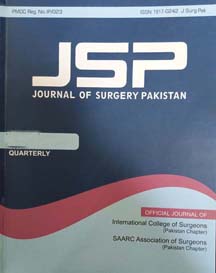Clinical Characteristics of Gynecological Malignancies: A Retrospective Analysis
Haleema Yasmin, Omema Akhtar, Mairman Achakzai, Memoona Rehman, Samra Rizwan, Mahrukh Hyder
Abstract
Objective
To find out the clinical presentations, histopathological patterns, and treatment modalities for the gynecological malignancies.
Study design
Retrospective cross-sectional study.
Place & Duration of study
Department of Obstetrics and Gynecology Ward 08, Jinnah Postgraduate Medical Centre, Jinnah Sindh Medical University Karachi, from January 2022 to December 2024.
Methods
The records of all the patients diagnosed with gynecological malignancies (ovarian, endometrial, cervical, vulvar, vaginal, or gestational trophoblastic neoplasia) were retrieved. The file notes, operative details, histopathology reports, and other oncology related information were extracted and entered into a pre designed form. Variables collected included demographic data, risk factors, type of malignancy, staging according to the FIGO criteria and treatment modalities used. The data were entered into the SPSS version 30.0. Descriptive statistics were used to present the data.
Results
The records of 205 patients were reviewed that were found in conformity with the inclusion criteria. The mean age of the patients was 48.4±8.1 year. Most of the patients were multiparous (n=170 - 82.9%), overweight and obese (n=107 - 52.2%), and had comorbid conditions like diabetes mellitus (n=88 - 42.9%) and hypertension (n=41 - 20%), family history of cancer was noted in 103 (50.2%) 9+584 patients.
Ovarian cancer was the most common malignancy (n=106 - 51.7%), followed by uterine (n= 59 - 28.8%) and cervical neoplasms (n=26 - 12.7%). Most of the ovarian tumors were of FIGO stage III (n=46 - 43.4%), while endometrial malignancies were commonly diagnosed at stage II (n=21 - 35.6%), and cervical cancers at stage III (n=69 - 37.1%). Treatment provided included primary surgery (n=44 - 21.5%) and neoadjuvant chemotherapy followed by surgery (n=46 - 22.4%) as well as other modalities.
Conclusion
Ovarian malignancies were the most frequent tumors encountered in this series. They were diagnosed at an advanced stage. The treatment was tailored for each patient according to the stage of the tumor at presentation.
Key words
Gynecologic oncology, Cervical cancer; Endometrial cancer, Ovarian cancer, Human papilloma virus.

